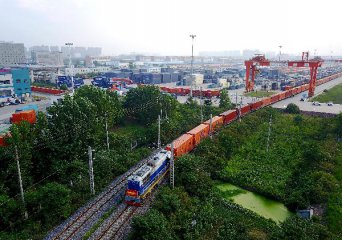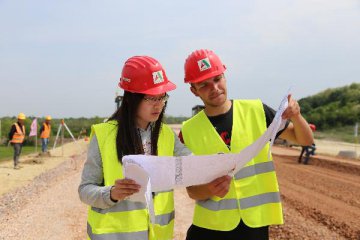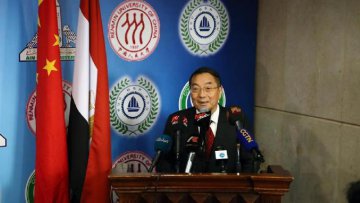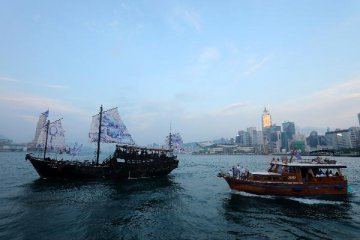
The Belt and Road Initiative, an open platform for building a community of shared future for mankind, is gaining more energy than ever, as the cooperation between China and Central Europe, Central and Eastern Europe, Africa, and Latin America, enters a new stage.
In the past year of 2018, more than 60 countries have signed Belt and Road cooperation documents with China. These countries spread across Asia, Africa, Oceania, Europe and Latin America. Since the Belt and Road Initiative was proposed, China has signed in total 170 intergovernmental cooperation documents with 122 countries and 29 international organizations.
Europe takes a more active role in Belt and Road
In April, Austrian president Van der Bellen headed an "unprecedented" high-level delegation on his state visit to China, including Austrian Chancellor Sebastian Kurz and four cabinet ministers. During this visit, Austria agreed to cooperate with China in Belt and Road construction, becoming the first developed member of the European Union to do so. After that, other European countries, such as Greece, Malta and Portugal, successively entered into the Belt and Road "circle of friends", showing that Europe's role in the Belt and Road is becoming more and more active.
China and these European countries can draw on their respective advantages, including market resources and trade relations, to cooperate in the third market, which creates a new model of B&R cooperation.
Soaring number of new partners from LatAm, Africa, and Pacific islands
In January, China and the Community of Latin American and Caribbean States (CELAC) made a special announcement on the Belt and Road Initiative, which was a clear sign of the participation of Latin America in the B&R construction. CELAC members unanimously said the vision to enhance infrastructure, trade and people-to-people ties worldwide has provided their countries with ample development opportunities, and hoped to join it to achieve common development with China.
Following that, half of the countries in Latin America joined the Belt and Road "circle of friends", and more than a dozen Latin American countries, including Chile, Uruguay, Venezuela, Bolivia, and Ecuador, signed B&R cooperation documents with China.
Specially, Trinidad and Tobago, China's largest trade partner in the English Caribbean area, signed a memorandum of understanding (MoU) with China. It has been the first MOU on the Belt and Road Initiative that China has signed with a country in the Caribbean area.
The Belt and Road is also becoming a new bridge that makes China and Africa, two traditional partners, even closer in the history. During the 2018 Beijing Summit of the Forum on China-Africa Cooperation (FOCAC), 28 African countries and the African Union Commission (AUC) signed B&R cooperation documents with the Chinese side. At present, the number of African participants in the B&R circle of friends has reached 37, bringing new historic development opportunities to both China and Africa.
It is worth noting that nine Pacific island countries became partners of the Belt and Road in 2018, including Papua New Guinea, Samoa, Fiji, the Federated States of Micronesia, the Cook Islands, and Niue - one of the smallest countries in the world. This is expected to strengthen their economic and trade ties with other countries in the world and help them better participate in the process of economic globalization.
In addition, state of Victoria, Australia reached an agreement with China to jointly build the Belt and Road in October 2018, becoming the first state government in Australia to do so. This fully demonstrates that the Belt and Road is an open initiative, which welcomes all kinds of partners, not only restricted to countries or international organizations.
New achievements were made in six geographical directions in 2018.
Under the joint efforts of neighboring countries, the Belt and Road construction is constantly progressing, with new achievements accumulated in six geographical directions.
Northward, the construction of China-Mongolia-Russia Economic Corridor has been accelerating. In May 2018, China and Eurasian Economic Union officially signed Trade and Economic Cooperation Agreement, which creates a new common ground for Sino-Russian cooperation in Belt and Road construction.
With closer cooperation, the bilateral trade volume between China and Russia in 2018 reached 107.06 billion U.S. dollars, surpassing 100 billion U.S. dollars for the first time, which marks an increase of 27.1 percent, the biggest growth rate among China’s top 10 trading partners.
Moreover, China and Russia has joined hands to implement major infrastructure projects. For example, at the beginning of 2018, a second line for the China-Russia oil pipeline began commercial operation, and at the end of the year, Yamal liquefied natural gas (LNG) project in Arctic Russia officially commissioned the third or last production line and reached its full capacity.
As for Mongolia, in November 2017, the Mongolian government introduced visa facilitation policies for the Belt and Road related personnel, which has come into effect in 2018, showing the country’s firm decision to support the Belt and Road.
Looking southwest, China and Myanmar signed a MOU to jointly build China-Myanmar Economic Corridor (CMEC) in September, 2018. The CMEC, an important part of the Belt and Road construction, starts in north from China's Yunnan Province, goes down south to the central Myanmar city of Mandalay, and further extends east to the new city of Yangon and west to the Kyaukpyu special economic zone. It is expected to bring China's experience of infrastructure construction to Myanmar and help boost the latter's economic development.
Westward, the China-Pakistan Economic Corridor (CPEC) is regarded as a "national priority" by the new government of Pakistan. At present, ten projects in four major CPEC cooperation areas have been completed, and 12 projects are under construction, creating 70,000 jobs for Pakistan, and driving the annual economic growth of Pakistan by 1 to 2 percentage points. It is worth noting that a bus service linking China and Pakistan was officially opened in November 2018, which is popular with the both peoples near the border of the two countries.
Southward, the Southern Transport Corridor (STC) initiated by China and Singapore, has officially changed its name to New International Land-Sea Trade Corridor,linking 155 ports in 71 countries and regions worldwide, and better connecting the Silk Road Economic Belt and the 21st-Century Maritime Silk Road.
Eastward, Japanese Prime Minister Shinzo Abe has completed his first visit to China by the Japanese Prime Minister in seven years, and expressed his strong will to participate in the construction of the Belt and Road. According to Abe, Japan is will actively explore cooperation with China in third market, to achieve mutual benefit and win-win results.
Looking to China's maritime neighbors, Cambodia and Indonesia, have respectively signed Belt and Road cooperation documents with China. Specially, Indonesia's vision of Global Maritime Fulcrum has strong complementarity with the Belt and Road Initiative.
The achievements in all six directions prove that the Belt and Road has brought, and will continue to bring participants with concrete benefits.





















Latest comments